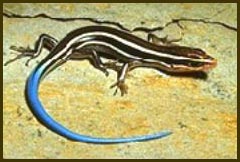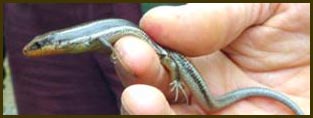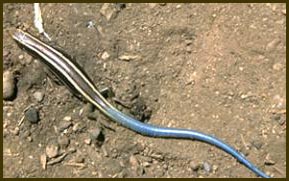A Review of the Western Skink
Laurina Manning

Western Skink (a.k.a. Skilton’s Skink) - Eumeces skiltonianus
Phylum: Chordata
Subphylum: Vertebrata
Class: Reptilia
Subclass: Lepidosauria
Order: Squamata
Sub-order: Sauria (Lacertilia)
Infraorder: Scincomorpha
Family: Skincidae (Skinks)
Genus: Eumeces
Species: skiltonianus
(EMBL Reptile database, 2001)
Habitat
Eumeces skiltonianus, the Western Skink, is a plentiful, shy, somewhat obscure lizard that occupies the United States in areas west of the Rocky Mountains. It was once believed that all skinks in the area were stages or sub-species of the species skiltonianus, but beginning in 1935 it was discovered that there were several, less numerous but distinctly separate species within the Eumeces genus (Rogers and Fitch 1947).
Eumeces skiltonianus is a hardy and adaptable lizard widely distributed west of the Rocky Mountains occupying a contiguous stretch of area extending up into extreme southern Canada down to latitude 29° North on the Baja peninsula of California, but absent from the Sierra Nevadas. The range continues westward, including desert canyons, and open woods, favoring habitats that are elevated (hillsides), have dead wood and/or flat rocks, scattered vegetation, and where some moisture is found. They live from low to high elevations from the Rocky Mountains, through the Cascades and Coastal ranges halting about 15 miles from the coast. (Rogers and Fitch 1947, Rodgers and Memmler 1943, Nussbaum et al. 1983, Pope 1971).
E. skiltonianus overlaps very little in microhabitats with its fellow species of Eumeces (Rodgers and Fitch 1947). Where one species of Eumeces begins there is only a very slight overlap where another species of Eumeces will end (Rodgers and Fitch 1947). Studies done in the Great Basin area, show that skiltonianus occupies open, rocky, mid-easterly slopes of the pinion-juniper woodlands above 2100 meters preferring the cooler, higher areas of certain mountain ranges. Its cousin E. gilberti is found primarily on the slope bottom below 1900 meters, though in similar open, rocky, pinion-juniper woodland areas (Morrison et al. 1999, Morrison and Hall 1999, Rogers and Fitch 1974, Gordon, 1939).
In Oregon, E. skiltonianus is found in the Coastal range and on both sides of the Cascade range, the Siskiyou region where the Coast and Cascade mountains meet, and the Great Basin physiographic province. It is found in the Willamette Valley on south facing rocky hillsides and in the Columbia River areas of Milton-Freewater and Pendelton where rainfall is low, summers are hot and the vegetation is largely sagebrush and bunch grass. It is found in Southeastern Oregon on the east flank of the Cascades, in the Klamath lake section and the Great Basin forms in low, hot valleys as previously described. (Gordon, 1939).
Physical Appearance and Identification
Juvenile E. skiltonianus are dark brown to black color that fades to a range of colors from olive to brown to blue-gray depending on location and molt stage. E. skiltonianus retains its juvenile pattern of stripes throughout its life, unlike other Eumeces species. (Gordon 1935, Nussbaum et al.1983, Rodgers and Fitch 1947).

Photo by manning shows orange
breeding color of a male.
Dorsally there are two stripes both of which can be white, gold, or cream color. The individual scales of the light lines are not well outlined. There is a larger dorso-lateral line that begins over the eye and extends back into the tail and fades. Smaller lateral stripes begins on the head at the lower jaw and extends back to the anterior portion of the hind legs. The ventral surface of E. skiltonianus is cream to gold color as well.
During breeding season, breeding age males (about three to six years old) develop an orange to yellow or red color on the lower jaw, lower head and snout region. In other respects the sexes are quite similar. Both sexes have seven supralabial scales and two pair of nuchal scales. (Rodgers and Fitch 1947, Nussbaum et al. 1983).

Photo by John Tashjian
The tail is one of the most remarkable features of E. skiltonianus. The tail is 1.5 to 2.0 times the body length of the skink. In the juvenile the tail is a vivid bright blue. This tail color and body color fades with age and molts. The tails of adults range from light blue to very light powder blue to gray tail. These variations occur with age and local. The ventral side of the adult tail may be pinkish in older blue tailed E. skiltonianus (Nussbaum et al., 1983 Fitch and Rodgers 1947). Although tails in both sexes of adults are fainter of color than the juveniles, tails of the males are usually brighter blue than females which are quite dull (Tanner 1943).

Photo by Manning shows orange head and blue tail.
Hatchlings are about 24.7 to 26.3 mm from snout to vent. Most growth in E. skiltonianus takes place during the first three months of life (Rogers and Memmler 1943). Juvenile male legs and adult male legs are equal in length, while juvenile females have longer leg to body ratios than adults. The adult females have comparatively longer trunks than juveniles. The snout-vent length in males was longer (62.9mm to 65.5mm) than females (63.3mm-64.9mm), but only by approximately 1 mm. The sexes are very similar in appearance and size (Rogers and Fitch 1974).

An adult skink, picture by Manning.
E. skiltonianus reaches sexual maturity at age two, but begins actively breeding at about age three. They are active breeders until age six. The oldest specimens found are believed to be nine years old (Rogers and Fitch 1974, Rogers and Memmler 1943, Pope 1971).
Predators and Prey
The main food source for E. skiltonianus is small arthropods including crickets, beetles, moths, grasshoppers and flies. E. skiltonianus hunts its prey, moving with rapid jerky motion,s stalking and striking in a snakelike fashion (Nussbaum et al. 1983, Tanner 1943). E. skiltonianus is diurnal, but they are very secretive and hide under rocks, cracks, crevices, or their burrows (which can be up to 50 cm long) when approached (Nussbaum et al. 1983).
To deter predators, their tail is easily autotomized if grabbed, and wriggling and jumping of the newly autotomized tail can last for several minutes, attracting predators and giving E. skiltonianus an opportunity to slip away unnoticed. (Nussbaum et al. 1983, Tanner 1943).
Maturity and Reproduction
The breeding season is May through June (Nussbaum et al., 1983 Tanner 1943). Males and females live separately. Males live nearby females, under rocks in short tunnels rather than an enlarged burrow (Tanner 1943). Females nest on south facing rocky hills, under rocks in the open, or under rocks that are partially covered by sage, oak or junipers. Under these rocks the female digs loose moist earth burrows which can be up to 50 cm long (Tanner 1943). E. skiltonianus females protect their young. The brooding female stays with her eggs and hatchlings, fiercely guarding them until they are old enough to leave the burrows. Nests will be increased in size and females will move eggs farther back from burrow entrance if they are disturbed or feel threatened (Tanner 1943).
There is only one clutch per year, hatching in late July or August, with two to six eggs in a clutch, the most common number being four (Punzo 1982, Nussbaum et al. 1983, Tanner 1943, Memmler 1943). All eggs are 15-16.9 mm long, and 9-10 mm wide and uniformly white in color. (Tanner 1943, Punzo, 1982 Rogers and Memmler 1943).
References:
GORDON, K. 1939. Distributional Areas. Pages 10 - 16 in Oregon State Monographs, Studies in Zoology, Number One - The Amphibia and Reptilia of Oregon. Oregon State University.
MORRISON, M. L., AND HALL, L. S., 1999. Habitat Characteristics of Reptiles in Pinyon-Juniper Woodland. Great Basin Naturalist 59(3):228-291.
MORRISON, M. L., AIGNER, P. A., NORDSTROM, L. A., AND HALL, L. S., 1999. Habitat Characteristics of Sympatric Gilbert’s and Western Skinks. Herpetological Review 30(1):18-20.
NUSSBAUM, R. A., BRODIE, D. E., AND STORM, R. M. 1983. Family Scincidae. Pages 243-246 in Amphibians and Reptiles of the Pacific Northwest. Idaho Press, Moscow ID.
POPE, C. H. 1971. General Account. Pages 241-296 in The Reptile World. Alfred A Knopf, New York, NY.
PUNZO, F. 1982. Clutch and Egg Size in Several Species of Lizards from the Desert Southwest. Journal of Herpetology 16(4):414-417.
RODGERS, T. L. AND FITCH, H. S. 1947. Variation in the Skinks (Reptilia: Lacertilia) of the Skiltonianus Group. University of California Publications in Zoology 48(4):169-220.
RODGERS, T. L. AND MEMMLER, V. H. 1943. Growth in the Western Blue-Tailed Skink. Transactions of the San Diego Society of Natural History 10(3):61-68.
TANNER, W. W. 1943. Notes of the Life History of Eumeces skiltonianus skiltonianus. The Great Basin Naturalist 4(3 & 4): 81-88.
The EMBL Reptile database
Thure Etzold, European Bioinformatics Institute
Ramu Chenna, European Molecular Biology Laboratory
Copyright © 1995-2001 by Peter Uetz and EMBL Heidelberg. Created: 10 Nov 1995 / Last changed or updated: 17 March 2001.
All photos by L. Manning, author, were taken on a male captured and released at on a rocky, south facing slope in late June, 2001 by Wildcat creek in the Coastal Range of Oregon, thirty miles east of Florence, OR.
Some text to make the picture show up.
